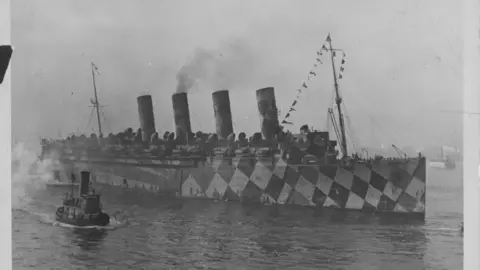Did WW1 'dazzle camouflage' really work?
 Getty Images
Getty ImagesWarships camouflaged with zig-zags, swooping curves and bright bursts of colour became a regular sight during World War One.
It sounds bizarre, drawing attention rather than trying to hide, but "dazzle camouflage" was a real idea used by both the US and Royal navies to try and fool German submarines.
A team from Aston University in Birmingham has concluded that it could have helped to disguise a boat's movements, but in a lesser way to that foreseen by its inventors.
The outlandish paintwork has also been overtaken by modern tracking using radar and sonar.
Prof Tim Meese and Dr Samantha Strong from Aston re-examined a 105 year-old experiment which represents the only attempt to try to understand the effectiveness of dazzle camouflage.
They re-ran the experiment, carried out by Leo Blodgett, a young student at Massachusetts Institute of Technology (MIT) in the US.
Leo used model ships on a canvas sea to try out various patterns and see what effect they had on those watching.
 Getty Images
Getty ImagesDr Strong explained the point of dazzle "isn't to disguise the ship... rather you are disguising the ship's intention".
While dazzle camouflage may even have drawn attention to the ship, the aim was to confuse an enemy captain's perception about its direction of travel - making it much harder to hit with a torpedo.
Dazzle produces a "twist effect" according to Prof Meese, confusing onlookers into believing the ship is heading in a different direction to its real one.
It is a real effect and this century-old experiment did find and measure it, but today's scientists believe there is a second, "horizon" effect.
 Getty Images
Getty ImagesObservers of a distant ship travelling along the horizon may think the ship is moving along the horizon itself, but it can actually be moving away from or towards the viewer by as much as 25 degrees.
"The twist effect was there but was much weaker than was perhaps thought back in the day," said Prof Meese.
The horizon effect is much more important in disguising the ship's direction, the scientists concluded. Dazzle can work but it is quite a small effect on its own.
In the end, technology put paid to dazzle camouflage, as tracking by sonar and radar came to the fore, and put an end to the intriguing experiment in camouflage.
However, the Aston University scientists concluded that lone student Leo Blodgett demonstrated how a zig-zag, spotty and stripy paint job could have some value in protecting allied ships.
Follow BBC Birmingham on BBC Sounds, Facebook, X and Instagram.
